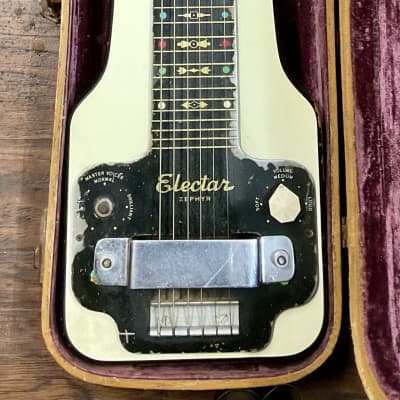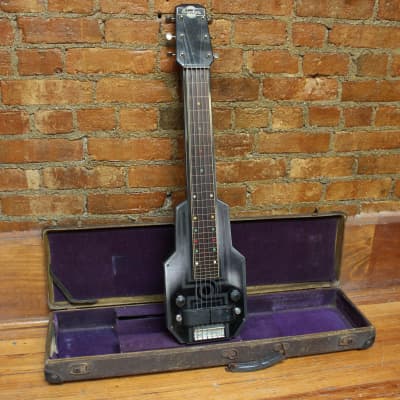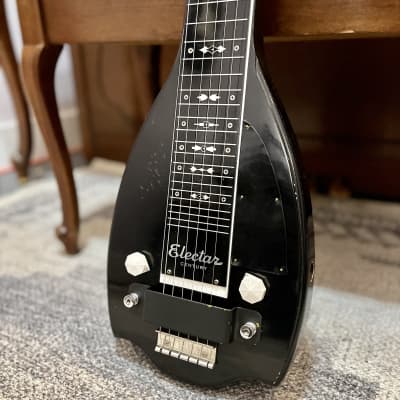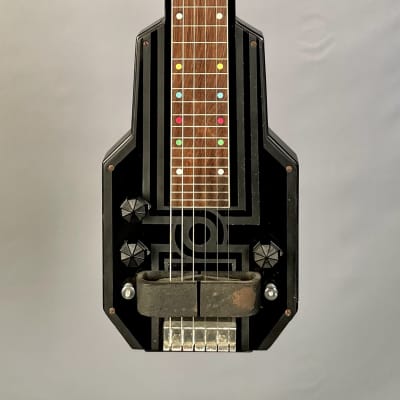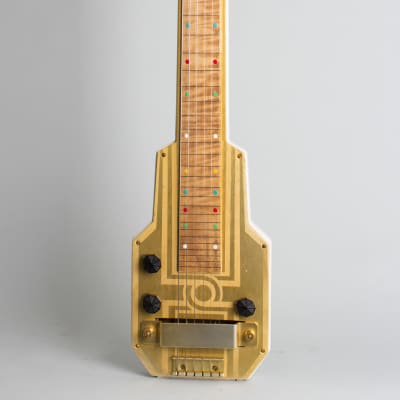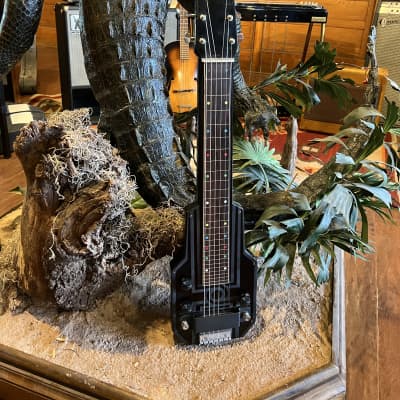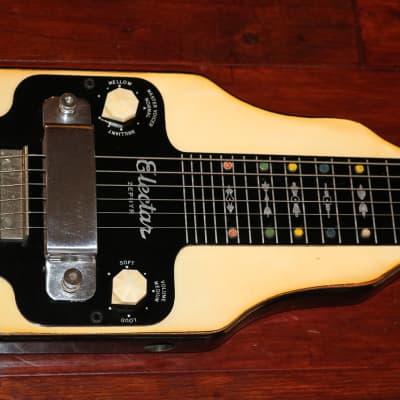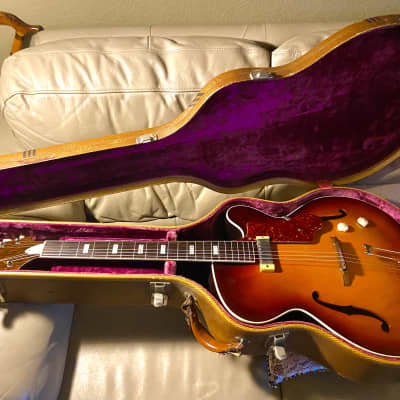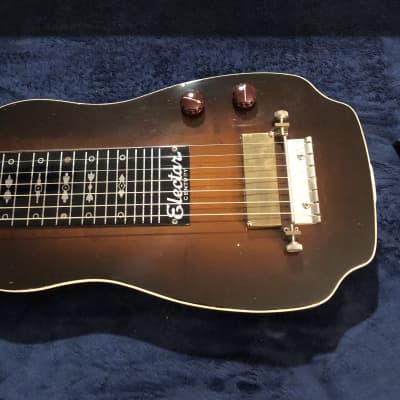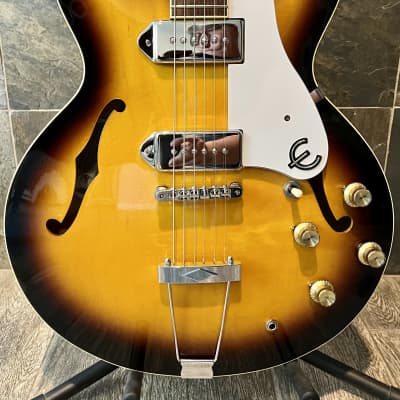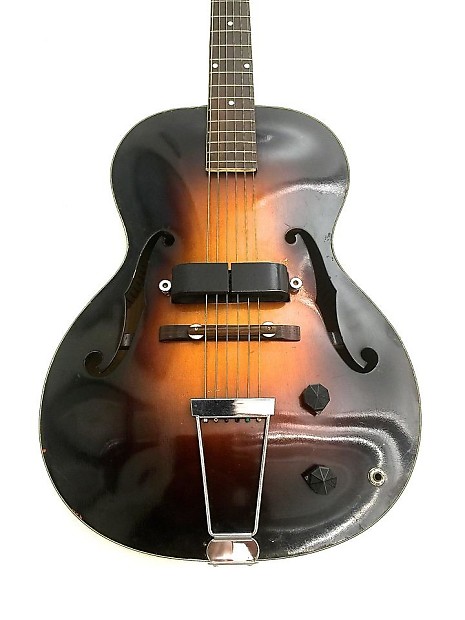

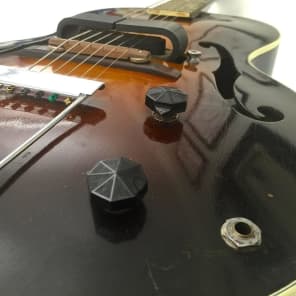
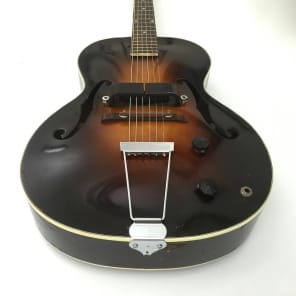
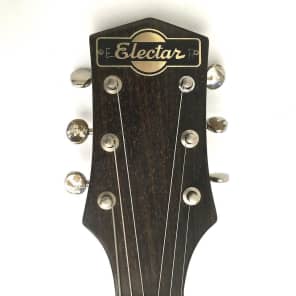
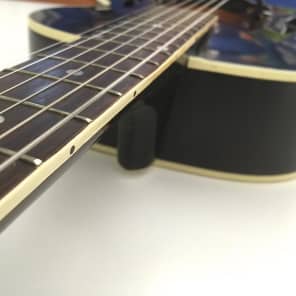
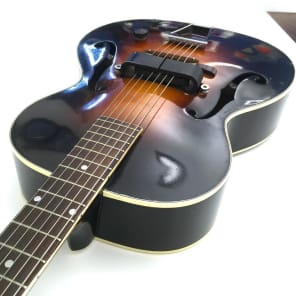
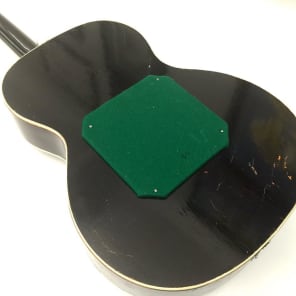
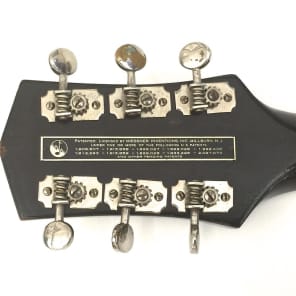
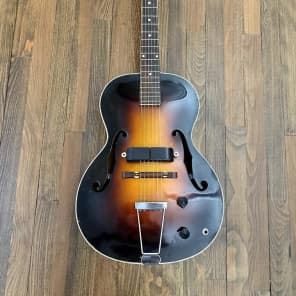
We just received this amazing original 1936 Epiphone Electar Spanish
Electric guitar and it plays and sounds awesome. Action is set nice and
low and neck is perfectly straight enabling comfortable play over the
entire fretboard. It's got that old horseshoe pickup and it's strong
and sounds great. These instruments were built during the time when
electric guitars were just really being experimented on with just a
couple of known musicians using them at the time.
This 14 3/4-inch-wide Grand Concert size guitar weighs 7.10 lbs. and was Epiphones very first electric model. The arched top is laminated maple, the flat back and sides are also laminated maple single-bound in white pyralin. The one-piece mahogany neck with a scale length of 25.50 inches has a nice soft "V" profile and a nut width of just under 1 11/16 inches. The single-bound rosewood fretboard has 20 jumbo frets and inlaid pearl dot position markers. Headstock with gently pointed peak and metal Electar logo plate. Individual open-back Grover 'sta-tite' tuners with oval metal buttons and slot-head screws. Single Epiphone Model M Horseshoe Magnet pickup situated in the center of the top with two wheels for adjusting the height. Two controls for volume & tone all mounted on the treble bout. Epiphone octagonal black Bakelite knobs with small pointers. Rosewood bridge on rosewood base with two height adjustment wheels and Epiphone trapeze tailpiece. The serial number ("471") is stamped onto the treble top-edge of the headstock. Affixed (by four screws) to the back of the guitar is the original cloth covered 3/16 inch plywood panel measuring 6 7/8 x 7 inches which covers an aperture of 5 7/8 x 6 inches (with rounded corners) which allows access to the electrics. There is some general wear from play over the years, the binding has shrunk a little in some areas and a piece of binding along the bottom treble side of the neck is missing. The original pyralin neck heel cover has been replaced with a hand cut piece of polystyrene, otherwise the binding is intact with no signs of cracking or break down. The logo plate also has the initials E and P scribed on either end of the Electar logo. Overall the rich sunburst finish with chocolate brown sides, back and neck are in excellent (8.50) condition. Housed in a modern TKL black hardshell case.
"Electro was a competitor, to be sure, but Epi's foremost competition would come from Gibson. The Electar line was announced in November 1935, just as Gibson was testing the waters with it's first electric, a metalbody Hawaiian steel guitar. Although Rickenbacker's first offerings had been metal, metalbody guitars didn't fly under the Gibson banner, and Gibson replaced the model with a woodbody Hawaiian at the beginning of 1936. The Gibson pickup had a metal plate protruding from the coil upward the strings. The end of the plate was notched so that the three highest-pitched strings appeared to have individual polepieces. When Gibson put it on a standard guitar, there were initially no notches, but in later versions the area under the second string was notched. Obviously the output was not always even across the entire pickup "bar" (to the player it looked like a bar rather than a plate)... Catalogues never showed it, but most of the Epi hollowbody electrics made prior to World War II had a large padded plate on the back that could be unscrewed and removed for easy access to the electronics. Although most musicians found it unnecessary to fiddle with the pickup and controls, it was that very feature that would bring an emerging guitar star named Les Paul into the Epi camp in the 1940's.
Epiphone electric guitars had another unusual feature: a metal plate noting that the instrument was made under license to Miessner Inventions, of Milburn, New Jersey. Miessner held several patents on electric keyboard instruments and claimed that all electric guitars utilized their patents. Epi complied with Miessner's licensing demands and listed 10 of Miessner's patent numbers on the metal plate attached to each instrument. Other makers fought Miessner, however, and Miessner's claims were eventually settled and dropped.
In a letter to dealers dated June 29, 1937, Epi reported that sales had doubled in the last year. The overall rise in popularity of the guitar undoubtedly contributed to the increase in sales. But part of Epi's success was based on it's image as an innovative company,, an image enhanced by the Master Pickup and a barrage of new features introduced in 1937 including the following: The Mastervoicer Tone Control, the catalogue claimed "enables the player to obtain a great variety of effects varying from a muted tone to that of the strident banjo with one turn of the knob."... Epi's "thrust rod" - obviously a play on Gibson's truss rod - was, like Gibson's, an adjustable truss rod in the neck. But unlike Gibson's, which adjusted at the headstock end of the rod, Epi's adjustment was at the body end of the neck, and it did not require removal of a truss rod cover. (Walter Carter. Epiphone The Complete Story, pp. 33 - 34.)
"The Model M was introduced in 1935 as the first Epiphone electric guitar and was produced until about 1939.
The body was the 14 3/4" Grand Concert size with a laminate maple pressed top, maple sides, a flat maple laminate back and a one-piece mahogany neck. The top, back and neck were bound in single-ply white pyralin. The rosewood fingerboard was inlaid with dot position markers at frets three, five, seven, nine and fifteen and a double dot at the twelfth fret. Tuners were a simple open-back design with either plastic or metal buttons. The peghead came to a gentle point and featured the "Electar" name. The instrument was finished in a sunburst on the top and chocolate brown sides, back and neck. The tailpiece, pickguard and adjustable bridge were the standard Epiphone design used on acoustic instruments of the time (though the pickguard was somewhat smaller). Besides having a flat back, two other ways in which this model differed from the acoustic archtops of the time were that the neck was mounted flush with the body rather than elevated, and the top was horizontally braced. This heavy bracing, according to the 1936 Electar catalogue, "properly supported and dampened [the top] in order to avoid after tones and acoustic feedback."
This instrument was fitted with the Model M pickup, a rather bulky horseshoe magnet pickup which was mounted through a rectangular access hole through the back. This hole was approximately 4" x 6" and was covered with [a]cloth-wrapped plated screwed to the back. The pickup was mounted to maple blocks glued to the underside of the top and projected through a hole cut in the face of the instrument in the bridge position. The poles of the magnet wrapped over the strings and included two magnets under the strings. The visible part of the magnet was nickle-plated on early models; later models featured an "oven-backed, black crinkle finished." Volume and tone controls were mounted on the lower treble bout in a line parallel to the strings. The input jack was also on the top near the edge and the control knobs, in an octagonal shape with a small pointer, were black, Bakelite. The earliest examples from 1935 lacked the tone control, and the volume also incorporated an on/off switch... An innovative, though short-lived (less than one year) feature, was the "Rhythm Control," announced in a letter to dealers dated June 29, 1937. This consisted of a third control knob on the face of the instrument. It was said to "enable the player to execute the fastest rhythms without blurring or running together of chords."... The Electar Model M was discontinued by 1939. (Fisch & Fred. Epiphone The House of Stathopoulo. pp. 116-117).
This 14 3/4-inch-wide Grand Concert size guitar weighs 7.10 lbs. and was Epiphones very first electric model. The arched top is laminated maple, the flat back and sides are also laminated maple single-bound in white pyralin. The one-piece mahogany neck with a scale length of 25.50 inches has a nice soft "V" profile and a nut width of just under 1 11/16 inches. The single-bound rosewood fretboard has 20 jumbo frets and inlaid pearl dot position markers. Headstock with gently pointed peak and metal Electar logo plate. Individual open-back Grover 'sta-tite' tuners with oval metal buttons and slot-head screws. Single Epiphone Model M Horseshoe Magnet pickup situated in the center of the top with two wheels for adjusting the height. Two controls for volume & tone all mounted on the treble bout. Epiphone octagonal black Bakelite knobs with small pointers. Rosewood bridge on rosewood base with two height adjustment wheels and Epiphone trapeze tailpiece. The serial number ("471") is stamped onto the treble top-edge of the headstock. Affixed (by four screws) to the back of the guitar is the original cloth covered 3/16 inch plywood panel measuring 6 7/8 x 7 inches which covers an aperture of 5 7/8 x 6 inches (with rounded corners) which allows access to the electrics. There is some general wear from play over the years, the binding has shrunk a little in some areas and a piece of binding along the bottom treble side of the neck is missing. The original pyralin neck heel cover has been replaced with a hand cut piece of polystyrene, otherwise the binding is intact with no signs of cracking or break down. The logo plate also has the initials E and P scribed on either end of the Electar logo. Overall the rich sunburst finish with chocolate brown sides, back and neck are in excellent (8.50) condition. Housed in a modern TKL black hardshell case.
"Electro was a competitor, to be sure, but Epi's foremost competition would come from Gibson. The Electar line was announced in November 1935, just as Gibson was testing the waters with it's first electric, a metalbody Hawaiian steel guitar. Although Rickenbacker's first offerings had been metal, metalbody guitars didn't fly under the Gibson banner, and Gibson replaced the model with a woodbody Hawaiian at the beginning of 1936. The Gibson pickup had a metal plate protruding from the coil upward the strings. The end of the plate was notched so that the three highest-pitched strings appeared to have individual polepieces. When Gibson put it on a standard guitar, there were initially no notches, but in later versions the area under the second string was notched. Obviously the output was not always even across the entire pickup "bar" (to the player it looked like a bar rather than a plate)... Catalogues never showed it, but most of the Epi hollowbody electrics made prior to World War II had a large padded plate on the back that could be unscrewed and removed for easy access to the electronics. Although most musicians found it unnecessary to fiddle with the pickup and controls, it was that very feature that would bring an emerging guitar star named Les Paul into the Epi camp in the 1940's.
Epiphone electric guitars had another unusual feature: a metal plate noting that the instrument was made under license to Miessner Inventions, of Milburn, New Jersey. Miessner held several patents on electric keyboard instruments and claimed that all electric guitars utilized their patents. Epi complied with Miessner's licensing demands and listed 10 of Miessner's patent numbers on the metal plate attached to each instrument. Other makers fought Miessner, however, and Miessner's claims were eventually settled and dropped.
In a letter to dealers dated June 29, 1937, Epi reported that sales had doubled in the last year. The overall rise in popularity of the guitar undoubtedly contributed to the increase in sales. But part of Epi's success was based on it's image as an innovative company,, an image enhanced by the Master Pickup and a barrage of new features introduced in 1937 including the following: The Mastervoicer Tone Control, the catalogue claimed "enables the player to obtain a great variety of effects varying from a muted tone to that of the strident banjo with one turn of the knob."... Epi's "thrust rod" - obviously a play on Gibson's truss rod - was, like Gibson's, an adjustable truss rod in the neck. But unlike Gibson's, which adjusted at the headstock end of the rod, Epi's adjustment was at the body end of the neck, and it did not require removal of a truss rod cover. (Walter Carter. Epiphone The Complete Story, pp. 33 - 34.)
"The Model M was introduced in 1935 as the first Epiphone electric guitar and was produced until about 1939.
The body was the 14 3/4" Grand Concert size with a laminate maple pressed top, maple sides, a flat maple laminate back and a one-piece mahogany neck. The top, back and neck were bound in single-ply white pyralin. The rosewood fingerboard was inlaid with dot position markers at frets three, five, seven, nine and fifteen and a double dot at the twelfth fret. Tuners were a simple open-back design with either plastic or metal buttons. The peghead came to a gentle point and featured the "Electar" name. The instrument was finished in a sunburst on the top and chocolate brown sides, back and neck. The tailpiece, pickguard and adjustable bridge were the standard Epiphone design used on acoustic instruments of the time (though the pickguard was somewhat smaller). Besides having a flat back, two other ways in which this model differed from the acoustic archtops of the time were that the neck was mounted flush with the body rather than elevated, and the top was horizontally braced. This heavy bracing, according to the 1936 Electar catalogue, "properly supported and dampened [the top] in order to avoid after tones and acoustic feedback."
This instrument was fitted with the Model M pickup, a rather bulky horseshoe magnet pickup which was mounted through a rectangular access hole through the back. This hole was approximately 4" x 6" and was covered with [a]cloth-wrapped plated screwed to the back. The pickup was mounted to maple blocks glued to the underside of the top and projected through a hole cut in the face of the instrument in the bridge position. The poles of the magnet wrapped over the strings and included two magnets under the strings. The visible part of the magnet was nickle-plated on early models; later models featured an "oven-backed, black crinkle finished." Volume and tone controls were mounted on the lower treble bout in a line parallel to the strings. The input jack was also on the top near the edge and the control knobs, in an octagonal shape with a small pointer, were black, Bakelite. The earliest examples from 1935 lacked the tone control, and the volume also incorporated an on/off switch... An innovative, though short-lived (less than one year) feature, was the "Rhythm Control," announced in a letter to dealers dated June 29, 1937. This consisted of a third control knob on the face of the instrument. It was said to "enable the player to execute the fastest rhythms without blurring or running together of chords."... The Electar Model M was discontinued by 1939. (Fisch & Fred. Epiphone The House of Stathopoulo. pp. 116-117).
Reverb Buyer Protection
Reverb has your back if your item is lost, damaged, or doesn't match its description. Simply report any issues within 7 days and we'll help you get a full refund.Learn more about Reverb Buyer Protection.
| Listed | 9 years ago |
| Condition | Very Good (Used) Very Good items may show a few slight marks or scratches but are fully functional and in overall great shape.Learn more |
| Brand | |
| Model |
|
| Finish |
|
| Categories | |
| Year |
|
| Made In |
|
| Body Type |
|
